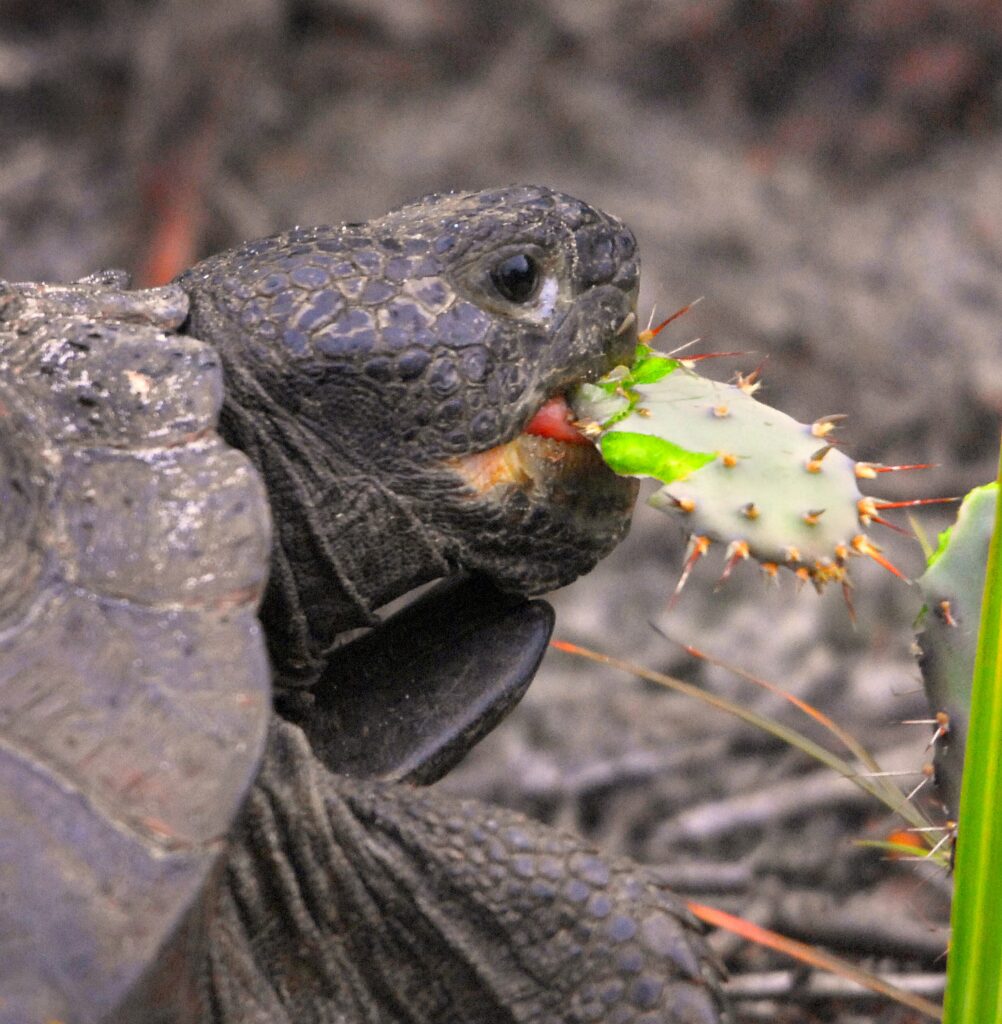
Image: Gopher Tortoise snacking on Opuntia Wikimedia Commons CC 2.0
Can tortoises eat cactus? It’s a tricky question, but the answer isn’t as simple as one might think. Some species of tortoises can eat certain types of cactus, but these prickly plants can cause digestive upset or even serious health issues for other species.
The desert tortoise and the sulcata tortoise can eat cacti as they have evolved to digest and tolerate this tough, fibrous plant material. But, Mediterranean tortoises like the Greek tortoise and Hermann’s tortoise won’t find cactus in their natural habitats and so should not eat it.
It’s important to research your tortoise’s specific dietary needs before introducing any new foods. Consulting with a reptile vet or an experienced breeder is a good idea to guarantee your pet’s well-being.
I learned this lesson myself when I offered a piece of cactus to my Russian tortoise, Sasha. She ate it with enthusiasm, but later showed signs of discomfort and couldn’t pass it through her digestive system. Clearly, different tortoise species have different food requirements.
Key Takeaways
- Tortoises can eat certain types of cactus, but it is important to choose the right species and prepare it properly.
- Opuntia cactus, also known as prickly pear cactus, is safe for tortoises to eat and can provide them with hydration and nutrients.
- It is crucial to remove all spines and prickles from the cactus before feeding it to the tortoise to prevent any injuries.
- Tortoises should only be given cactus as an occasional treat and not as a staple part of their diet.
- Feeding tortoises too much cactus can lead to digestive issues and dehydration, so moderation is key.
- It is recommended to consult with a veterinarian or reptile specialist to ensure the proper diet and nutrition for tortoises.
Can Tortoises Eat Cactus?
To ensure the well-being of your tortoise, it’s important to know if they can eat cactus. Discover the types of cactus suitable for tortoises and the precautions to keep in mind when feeding cactus to them. Get informed about their dietary options and make informed decisions for your reptilian companion.
What Types of Cactus Can Tortoises Eat?

Tortoises are herbivores. Cacti can be part of their diet, but it’s important to know which are safe. Here’s a table with safety levels:
| Cactus Type | Safety Level |
|---|---|
| Opuntia (Prickly Pear) | Safe |
| Echinocactus | Approach with caution |
| Ferocactus | Approach with caution |
| Mammillaria | Approach with caution |
| Astrophytum | Safe |
It’s best to check with a reptile vet before giving cactus to a tortoise. Remove any thorns or spines. Cut the cactus into small pieces. Cacti should only be occasional treats – not the main diet. Provide leafy greens and veggies for a balanced diet.
If in doubt, consult a reptile vet. Offer safe cacti along with other nutritious plant materials for your tortoise’s health and happiness. But take precautions – a tortoise-themed episode of Jackass isn’t on the menu!
Precautions When Feeding Cactus to Tortoises
Cacti make a great meal for tortoises, but some precautions should be taken!
- Firstly, any spines must be carefully removed.
- Secondly, only safe cacti, such as Opuntia or Prickly Pear, should be used.
- Thirdly, rinse the cactus with water to ensure that no dirt or chemicals are ingested.
- Fourthly, introduce cacti gradually and keep an eye out for any signs of discomfort.
- Lastly, provide a range of vegetables, grasses, and fruits for a balanced diet. It’s best to consult a reptile vet to get advice specific to your pet’s needs.
Lastly, be mindful of overconsuming cacti as it could lead to diarrhea due to its high water content.
Benefits of Feeding Cactus to Tortoises
Can tortoises eat cactus? Absolutely! Let’s learn how to prepare these prickly little snacks for our slow and steady friends. Cactus offers a few benefits when fed to tortoises. Firstly, its high water content is great for hydration in arid environments. Secondly, it’s packed with fiber, aiding digestion and preventing constipation. And lastly, it contains vitamins and minerals like vitamin A, C, and calcium that are essential for a healthy tortoise.
Yet, not all cacti are safe for tortoises, as some may have thorns or be toxic. Researching the specific type of cactus is crucial before offering it to them. Ancient civilizations like the Aztecs knew this, as they fed cactus to their animals. So, feeding cactus to tortoises can provide benefits for their overall well-being – just be sure to choose safe varieties.
How to Prepare Cactus for Tortoises

To prepare cactus for tortoises and ensure their safety, remove spines, wash the cactus thoroughly, and cut it into bite-sized pieces. Removing spines guarantees easy consumption, while proper washing eliminates any harmful substances. Finally, cutting the cactus into smaller portions makes it easier for tortoises to eat and digest.
Removing Spines
Cacti are a yummy snack for tortoises, but their spines can be a danger. Learn how to take out the spines safely.
Removing Spines:
- Put on some protective gloves.
- Take a pair of tongs or tweezers and grip each spine at the base.
- Pull the spine in the other direction of its growth.
- If there are tiny bits left, use a knife or spoon to scrape them off.
- Rinse the cactus off with water to make sure it’s spine-free before feeding.
Check the cactus pads again for any extra spines. These can harm your pet.
Once, Emily had done all this to prepare cacti for her tortoise. But, one spine stayed stuck. She got help from a vet who suggested warm water and gentle rubbing. Now, her tortoise enjoys his snacks without any troubles.
Remember to take care when prepping cacti for your tortoise! Make sure all the spines are gone for their safety and enjoyment! Just remember, it won’t scream like your ex did when you used their toothbrush!
Properly Washing the Cactus
Cleaning cacti for tortoisesis essential. Follow four simple steps to make sure your cactus is safe for them!
- Inspect: Check for damage and pests, like mites and mealybugs. Cut off any damaged parts.
- Prepare: Put on gloves, fill a basin with lukewarm water, and use mild dish soap.
- Wash gently: Submerge and clean the cactus with a soft brush or cloth. Don’t press too hard!
- Rinse: Use a spray bottle or running water until all soap residue is gone. Make sure there’s no excess water.
Remember; each cactus is different, so research your tortoise’s favorite. And never use harsh chemicals or detergents! Safety first.
Let me tell you a story about Shelley, the lucky tortoise. Her owner followed the cleaning routine. Shelley’s shell was shining because of it! So, take the extra step and wash your cactus for your tortoise. They’ll be grateful!
Cutting the Cactus into Bite-sized Pieces
Cutting a cactus into pieces is key when preparing it for tortoises. Here are some steps to make it safe and easy to eat:
- Choose a fresh, firm cactus pad. No signs of rot or damage.
- Wear gloves and remove thorns and spines with a sharp knife.
- Cut the pad into small bite-sized pieces. Easy to eat and digest.
- Rinse off dirt and debris with water.
Not all cacti are safe for tortoises. Avoid prickly pear cactus – it has too much oxalic acid. Also, never feed them store-bought cacti with chemicals or pesticides. Choose fresh and organic sources.
My pet tortoise Sheldon taught me a lesson. While prepping his food, I cut myself while removing thorns. Despite the pain, I had to ensure the cactus was safe and tasty!
Cutting cactus into pieces is essential for your tortoise. By following the above steps and sharing our stories, we can be great pet owners!
Feeding Cactus to Tortoises
To ensure a proper diet for your tortoise, explore the feeding of cactus to tortoises. Discover the ideal frequency and portion size of cactus as well as how to monitor your tortoise’s response to this prickly addition to their meal.
Frequency and Portion Size
A vital point to remember when it comes to tortoises is their feeding frequency and portion size. See the table below:
| Frequency | Portion Size |
|---|---|
| Daily | Small |
| Every Other Day | Medium |
| Twice a Week | Large |
It’s essential to consult a vet for personalized advice since each tortoise has different nutrition requirements. Offering a range of food ensures your pet tortoise gets a balanced diet.
Pro Tip: Keep track of your tortoise’s weight and adjust portion sizes for optimum health. Watching cacti being eaten by tortoises is like a slow-motion game of culinary Russian roulette!
Monitoring Tortoise’s Response to Cactus
Tortoises eat cactus, so it’s important to watch how they handle it. Knowing their reactions and behaviour helps us care for them better.
A table monitoring tortoises’ response to cactus shows interesting results. It includes their reaction time, how long they feed, and the amount of cactus they eat.
Further research has revealed extra details about their diet. Certain species are more likely to favour certain types of cactus for nutrition or taste. This allows us to create more tailored diets for captive tortoises.
A curious fact is that some tortoises can stay hydrated just by eating cacti with high water content. Just like picky eaters, they have a long list of preferences!
Other Dietary Considerations for Tortoises
Diet is really important for tortoises’ health and wellbeing. Besides the usual food items, there are other considerations when caring for these reptiles. Let’s take a look in the following table with some factors to consider.
| Dietary Consideration | Info |
|---|---|
| Calcium | Tortoises need calcium for shell growth and bone development. Get it from cuttlebone or powdered supplements. |
| Vitamin D3 | Sunlight is needed to make Vitamin D3, which helps absorb calcium. Artificial UVB lighting can also be used. |
| Fiber | High-fiber foods like grasses and leafy greens help with digestion. These should form a big part of their diet. |
| Protein | Hatchlings need protein, but adult tortoises don’t. Sources include insects, snails, and occasional lean meat. |
| Fruits | Fruits are treats – they have lots of sugar. Good options include berries, melons, and non-acidic fruits like bananas or papayas. |
Different tortoise species have different dietary needs based on their natural homes and evolution. Ask a reptile vet or research the species for more info.
To get the right diet:
- Offer a variety of leafy greens for vitamins and minerals.
- Avoid high-fat foods.
- Monitor food intake and adjust portion size.
- Provide fresh water for hydration, especially in warm months.
By understanding these dietary considerations, you can help your tortoise enjoy optimal health. A well-informed approach to nutrition is key!
Frequently Asked Questions
Q: Can tortoises eat cactus?
A: Yes, tortoises can eat certain types of cactus, but not all. They can safely consume Opuntia cactus, also known as prickly pear or nopales.
Q: Why can tortoises eat cactus?
A: Tortoises have evolved to eat tough and fibrous plants like cactus. Their digestive system is adapted to break down and extract nutrients from these types of vegetation.
Q: Are there any risks in feeding tortoises cactus?
A: Yes, there are some risks. The spines of the cactus can injure the tortoise’s mouth and digestive tract, so it is important to remove them before feeding. Additionally, overfeeding cactus can cause diarrhea or other digestive issues.
Q: How should I prepare cactus for my tortoise?
A: Before offering cactus to your tortoise, you should remove all the spines by scraping them off with a knife or peeling the skin. It’s also advisable to cut the cactus into smaller, bite-sized pieces to make it easier for your tortoise to eat.
Q: Can tortoises eat other types of plants?
A: Yes, tortoises have a varied diet that includes different types of plants and vegetation. They can eat leafy greens, herbs, flowers, and certain fruits in addition to cactus.
Q: How often should I feed my tortoise cactus?
A: Cactus should be offered as an occasional treat or part of a balanced diet. It is recommended to feed cactus to your tortoise once or twice a month, alongside other suitable food items.
Conclusion
Tortoises can eat cactus!
It provides hydration and nutrients. No need to worry about spines – they can navigate around them. But, be sure to remove any thorns or sharp spines before feeding.
Cactus offers health benefits too. It helps with dehydration in hot climates and the fiber aids digestion.
An amazing story of tortoises and cactus is set on a remote island. The Galapagos tortoises here consume prickly pear cacti exclusively. This unique diet has helped them become one of the largest species of tortoise in the world.
References




